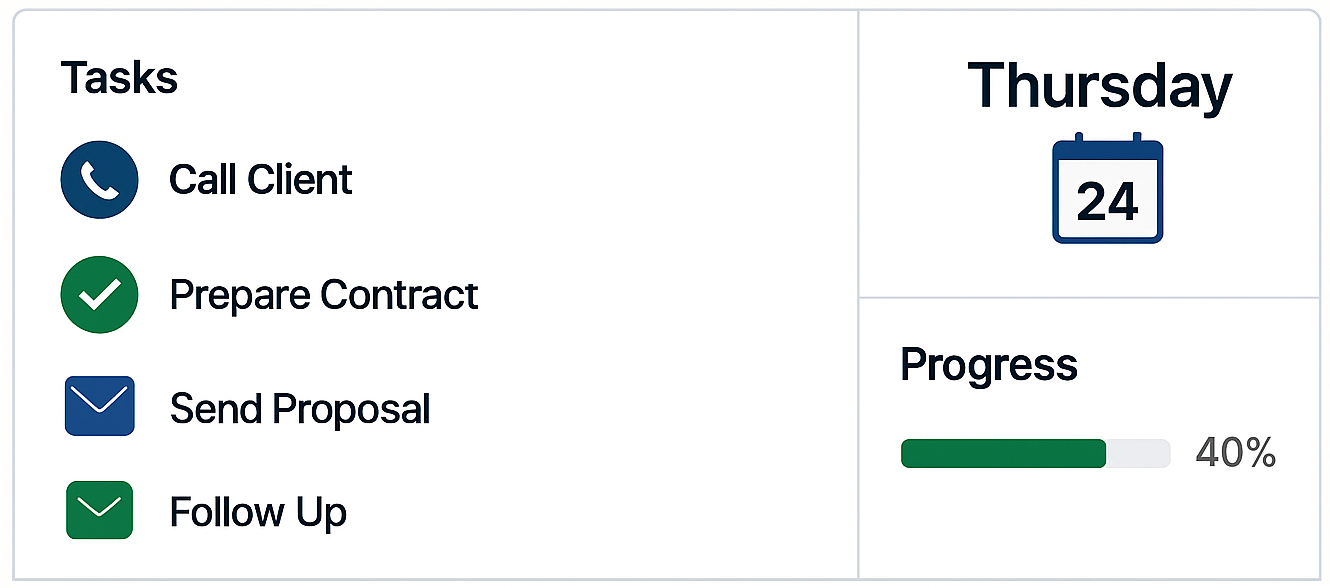
Sales
October 10, 2025
Pipedrive Sales Stages Explained
Discover (and master) the simple, visual tool that helps improve your sales process and smash more of your sales targets.
We don’t need a crystal ball to know you’ve got a process for attracting leads and driving sales – but it’s not as quick or efficient as you’d like.
Maybe you’re struggling with a high rate of stalled (or lost) leads, frustrated by inconsistent follow-ups, or using a generic approach that leaves prospects feeling like you don’t get them.
Enter Pipedrive’s sales pipeline: A simple way to break your sales process into trackable sales stages that everyone on your team can follow.
Knowing how to design, implement, and manage your sales stages is the secret sauce that helps your team —and your bottom line —thrive.
Ready to boost your revenue? Read on to learn how.
What is a Sales Pipeline?
OK, we know this is a little basic, but it’s worth repeating.
Your sales pipeline is an organised, visual way of tracking where each prospect is in your sales cycle. As prospects move through your pipeline by completing specific activities – which you can set in your CRM – you can support deals from start to close.
Since prospects progress towards a sale at varying speeds, your sales pipeline enables you (and your sales reps) to track and manage leads effectively by breaking the sales process into smaller, manageable tasks.
Inside your Pipedrive CRM, these are called stages.
When you know exactly where a potential buyer is in their journey, you can understand where deals are at any given time and identify opportunities to avoid roadblocks and drive sales at each stage.
How Do Pipedrive Sales Stages Work?
Think of each sales stage as a milestone.
These mark significant points in your sales journey, indicating that a deal has progressed. We’re not talking about individual tasks, such as "send an email" or "make a phone call” even though these are important.
Sales stages represent larger, more significant accomplishments and will vary depending on the products or services you sell.
Out of the box, Pipedrive comes with ready-made sales stages you can use right away.
Your default sales stages include:
- Qualified: You’ve identified a lead as a potential customer who meets the criteria set by your sales reps.
- Contact Made: You’ve successfully reached a prospect with a phone call, email or other form of contact.
- Demo Scheduled: You’ve arranged a product demo or meeting to introduce potential customers to your offering.
- Proposal Made: You’ve made a case why your business can solve your prospect’s problems, and a formal proposal or quote has been sent to the lead.
- Negotiations Started: The final stretch. You’ve started the process of discussing terms, pricing, and conditions.
Here’s what that looks like:

Image Credit: Pipedrive.com
Simple.
For some businesses, these default stages are fine. However, for most – and probably yours – a unique sales process will require some tweaking.
Luckily, Pipedrive makes it easy to add, remove or edit stages without feeling like you need a software degree.
Now is a good time to ask if your current Pipedrive sales stages reflect what your team does. If the answer is no, put on your hard hat because it's time for a little CRM renovation.
How to Edit Your Existing Pipedrive Stages
Go to the pipeline view and click the pencil icon to the right of the pipeline name. You can now edit and reorder your stages. Drag and drop them to match the order of your sales process.
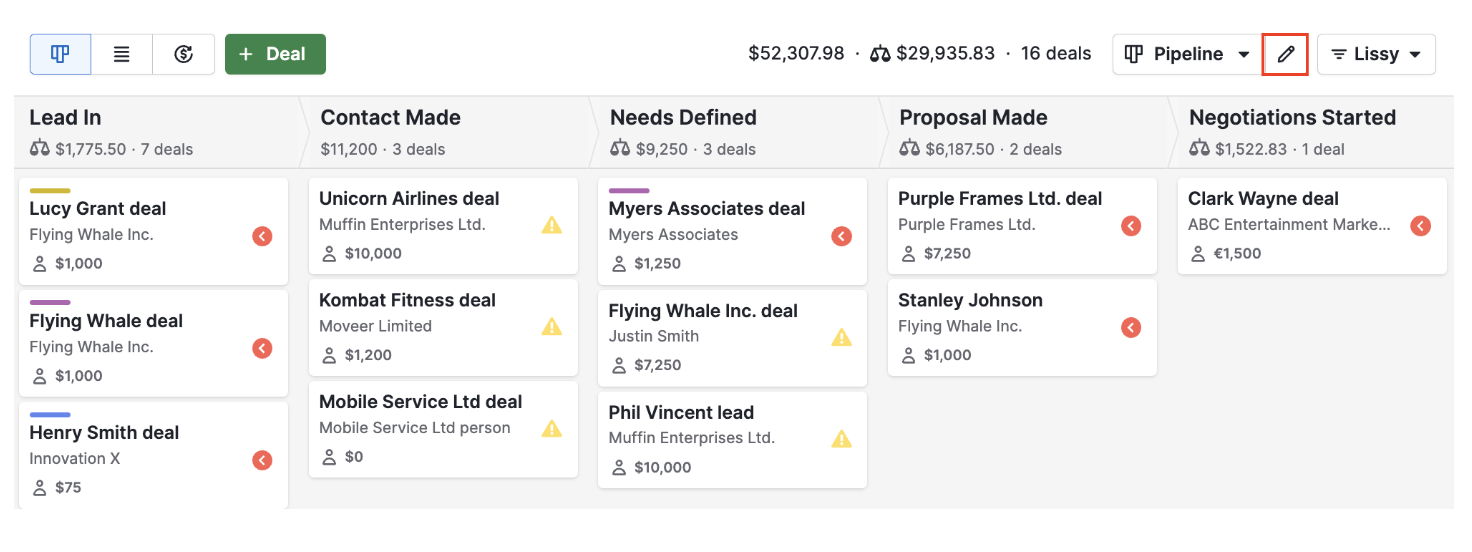
Image Credit: Pipedrive.com
You can also delete an existing stage by clicking“Delete Stage” at the bottom of the screen.
Once you’re satisfied with your sales stages, Pipedrive’s intuitive visual organiser helps you keep track of your team’s activities by organising deals based on the priority of that deal’s next-scheduled activity.
That means deals requiring immediate attention are moved to the top of each pipeline stage in the following order:
- Deals with a red icon have an overdue activity.
- Deals with a green icon have an activity scheduled for later today.
- Deals with a yellow icon don’t have an activity scheduled.
- Deals with a grey icon have an activity scheduled in the future.
If you want to customise each stage outside of the default sorting method, you can click the “Sort by“ dropdown on the right side of your pipeline view.
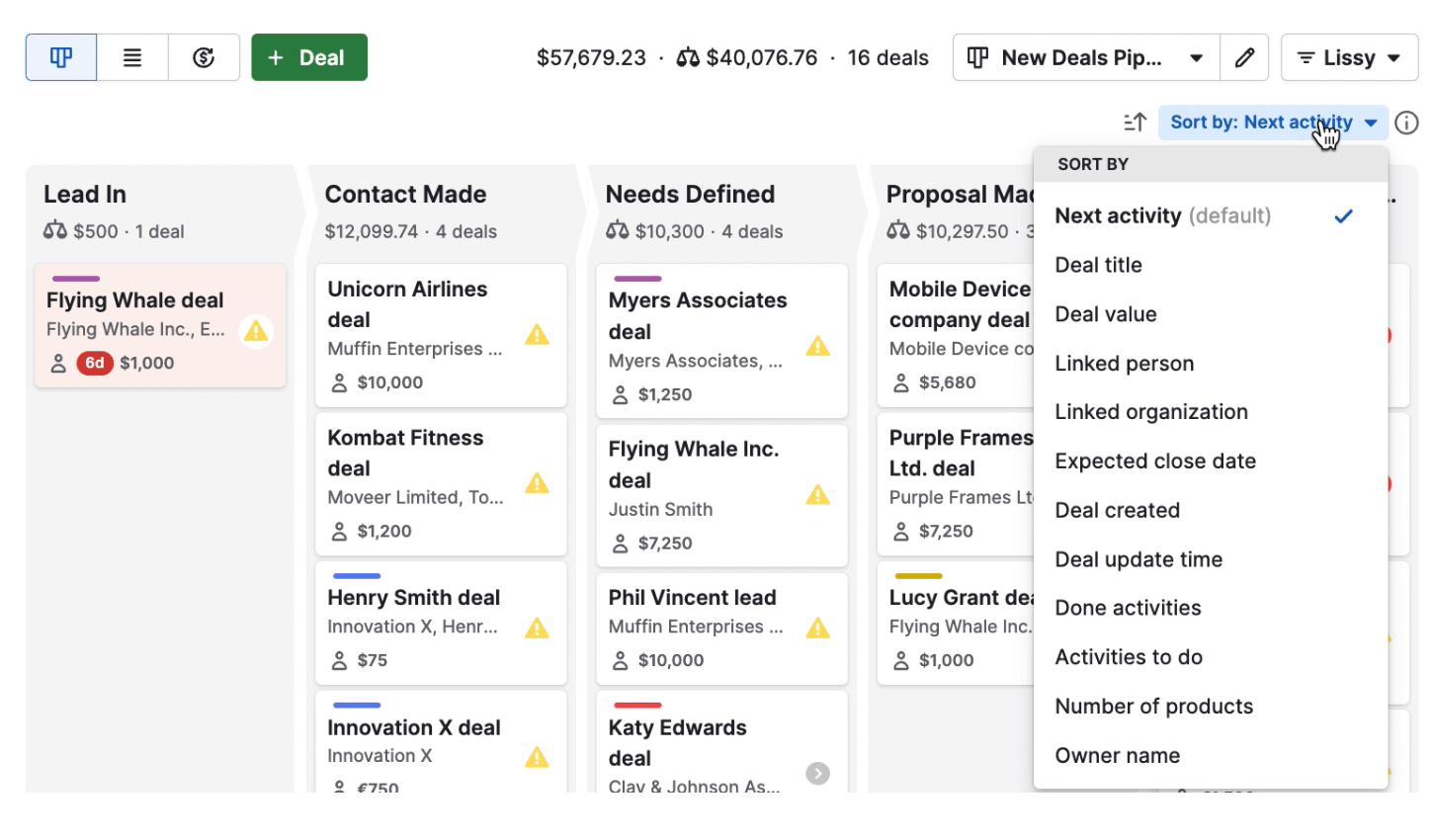
Image Credit: Pipedrive.com
How to Add a New Stage to Your Pipeline
To add a new stage to your pipeline, click the pencil icon next to your pipeline’s name or hover your cursor over a pipeline after opening the dropdown.

Image Credit: Pipedrive.com
Once you’ve selected the pipeline you want to edit, click the “+” between any two stages to add a new one in that location.
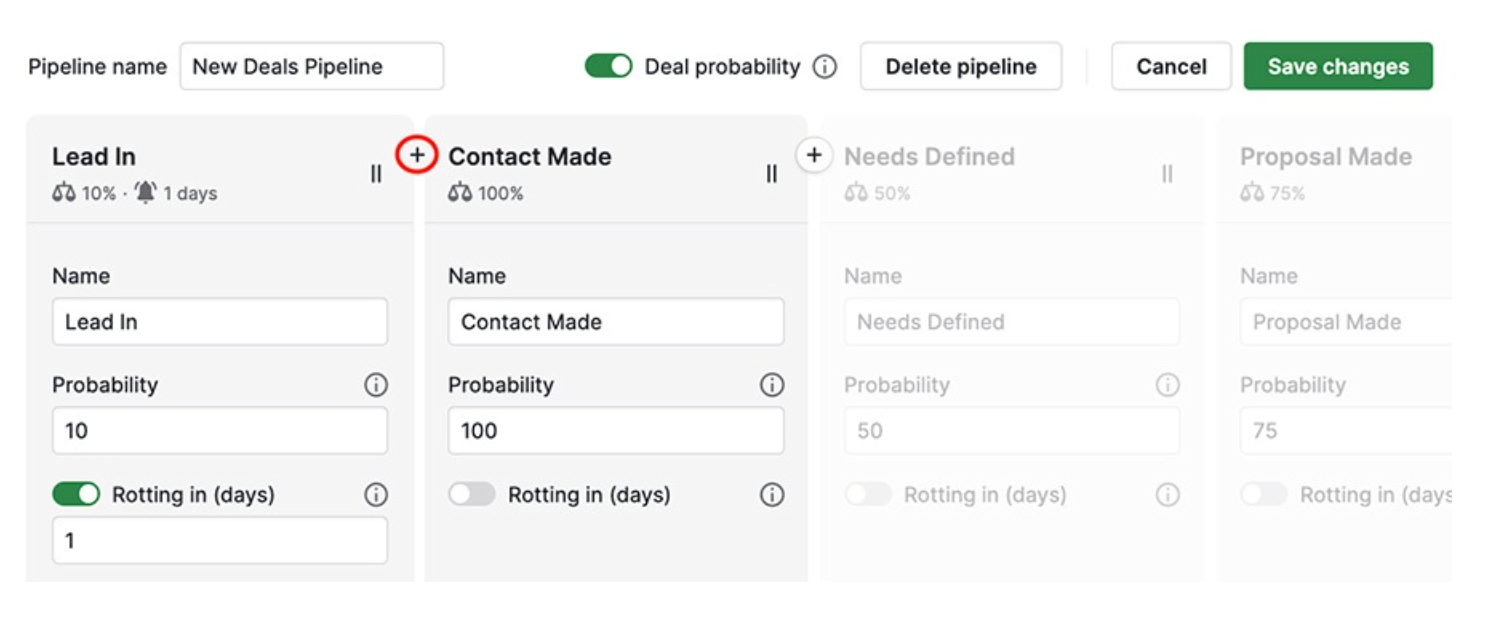
Image Credit: Pipedrive.com
You’ll see a new stage in the location you chose, where you can edit the name and rotting settings.
Pipedrive’s Rotting feature shows you which deals have been idle for too long.
Once enabled and configured, your pipeline will visually notify you of any deals that have remained untouched for longer than the defined rotting period. This helps prevent deals from falling through the cracks and gives your sales reps the awareness they need to take action.
As you create each stage, you'll also see an option to assign a stage Probability.
Pipedrive uses this number to calculate your probable revenue. For example, if the "Proposal Sent" stage leads to a sale 60% of the time, you can set that stage to 60%. This helps you forecast and make accurate decisions without guesswork.
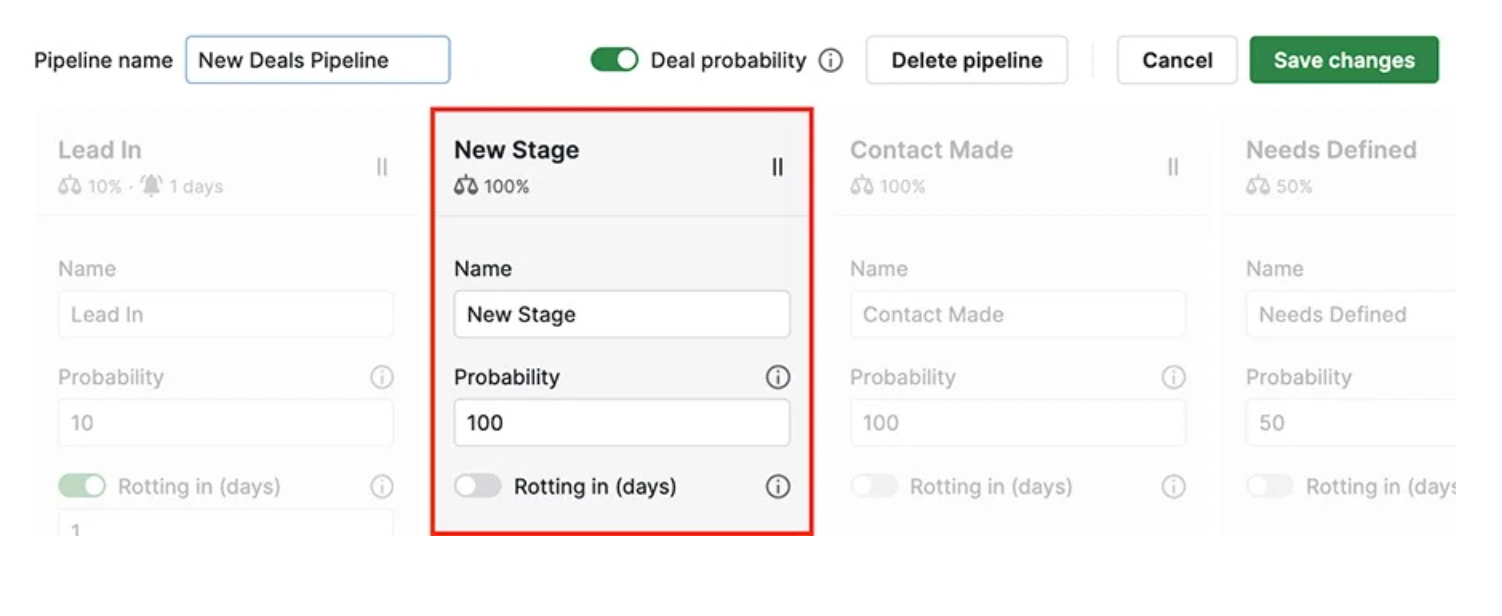
Image Credit: Pipedrive.com
The “Won” and “Lost” stages are the final destinations for all your deals.
When a deal is lost, Pipedrive will prompt you to provide a reason for the loss. Over time, you can analyse your lost deals to see if there’s a pattern, like losing to a specific competitor or pricing issues. This feedback is critical for improving your sales strategy.
Common Sales Stages Problems (And How to Avoid Them)
There’s no “one size fits all” approach to organising your sales stages because your process is as unique as your business.
Here’s what to avoid when managing your sales pipeline.
☒ Too Many Stages: It’s easy to get excited and create a new stage for every micro-action. This can make it seem like you’re having more “wins” but you’re really just confusing your team and making your pipeline a chore to manage. Somewhere between 5 and 9 stages is a sweet spot.
☒ Vague Stage Names: A stage named "Follow Up" is hard to define, which makes it hard to learn from. A stage like "Follow Up After Demo" or "Nurturing Post-Proposal" is more useful because it clearly indicates the type of follow-up and when it occurs.
☒ Forgetting to Define Exit Criteria: This is where the best-managed pipeline can turn into quicksand. If deals get pushed forward without a measurable action, you can’t forecast accurately. Always have a clear rule for moving a deal forward.
☒ Not Looking For Patterns: Certain interactions between reps and prospects may happen more than others. For example, if you’re a real estate agent, you may want to add a “reassure buyer” column if you face a lot of nervous buyers. You’ll need to keep an eye on your pipeline to identify any recurring patterns that can be categorised as sales stages.
☒ No Team Consistency: If one salesperson has their own custom stages and another uses the team's, your data is useless. The primary purpose of Pipedrive’s visual sales stage pipeline is to provide a single source of truth for your entire team.
Final Thoughts
A Pipedrive sales pipeline is like a GPS for your sales journey — it tells you where you are, where you’re headed, and what the next turn is.
To set up the stages in your pipeline, think about your team’s common sales activities and the ones you think have the most impact on sales. You can use Pipedrive’s default list of stages, or work out the steps in your own sales process and edit your pipeline to match.
Don’t be afraid to make changes if it feels like your pipeline needs more or fewer stages. Remember, regularly reviewing your pipeline will make it more accurate, which will help you determine what brings in revenue, so you can generate more of it.
Interested in learning how to optimise your sales stages? Schedule an obligation-free strategy call (it’s like a virtual coffee catch-up with no hard sell).



